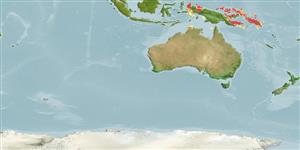>
Clupeiformes (Herrings) >
Spratelloididae (Small round herrings)
Etymology: Spratelloides: Old German, sprotte (1611) = a small fish, Clupea sp. + Greek, suffix, oides = similar to (Ref. 45335).
Eponymy: Dr Anthony David Lewis (d: 1948) is an Australian fisheries biologist and independent fisheries adviser who has joined the International Pole & Line Federation as a trustee (2014). [...] (Ref. 128868), visit book page.
Issue
The species in the genera Spratelloides Bleeker, 1851 and Jenkinsia Jordan & Evermann, 1896 should most probably be assigned to a separated family from Clupeidae and Dussumieriidae (Lavoué, pers. comm., July 2013). See a preliminary analysis in Lavoué et al. (2013: Ref. 93878).
Environment: milieu / climate zone / depth range / distribution range
ນິເວດວິທະຍາ
ສັດທະເລ; ລະດັບຄວາມເລິກ 0 - 50 m (Ref. 188). Tropical; 2°N - 12°S, 130°E - 164°E (Ref. 188)
Western Central Pacific: Solomon Islands, Papua New Guinea, and off Irian Jaya.
ຂະໜາດ / ນ້ຳໜັກ / Age
Maturity: Lm ? range ? - ? cm
Max length : 6.0 cm SL ຕົວຜູ້/ບໍ່ມີເພດ; (Ref. 188)
ຄີ (ໜາມ)ແຂງຢູ່ຫຼັງປາ (ທັງໝົດ) : 0; ຄີຫຼັງຂອງປາ (ຄີອ່ອນ) (ທັງໝົດ) : 12 - 13; ຄີ(ໜາມ) ແຂງຢູ່ຄີກົ້ນປາ
ກຸ່ມປາກະດູກແຂງ
ຄວາມຖີ່ຂອງກຸ່ມຖ່າຍທອດພັນ
ປາທີ່ມີການເຄື່ອນຍ້າຍຈາກທະເລໄປຫານ້ຳຈືດ ແລະນ້ຳຈືດຫາທະເລ
ປາທີ່ມີການເຄື່ອນຍ້າຍຈາກທະເລແລະໄປໄຂ່ຢູ່ນ້ຳຈືດ
ຄີກົ້ນຂອງປາ
ສັດທີ່ມີກະດູກສັນຫັຼງ
ການຖ່າຍທອດທາງກຳມະພັນຈາກພໍ່ແມ່ຫາລູກ: 0; ຄີກົ້ນຂອງປາ: 11 - 12. Distinguished from other species mainly by the silver band on the flanks which fades anteriorly (at about tips of pectoral fins). Maxilla toothed, triangular pre-maxillae, 2 supra-maxillae, second supra-maxilla asymmetrical (lower part larger than upper); vertical striae on scales not meeting at center; W-shaped pelvic scute.
Usually an inshore schooling species. More data needed. Used as bait in the tuna fishery. Found in coastal waters, sometimes forming large active schools at surface near reefs (Ref 90102).
Life cycle and mating behavior
ການຈະເລີນເຕັມໄວ | ການສືບພັນ | ການວາງໄຂ່ | ໄຂ່ | ຄວາມດົກຂອງໄຂ່ປາ | ຕົວອ່ອນ
Whitehead, P.J.P., 1985. FAO Species Catalogue. Vol. 7. Clupeoid fishes of the world (suborder Clupeoidei). An annotated and illustrated catalogue of the herrings, sardines, pilchards, sprats, shads, anchovies and wolf-herrings. FAO Fish. Synop. 125(7/1):1-303. Rome: FAO. (Ref. 188)
IUCN Red List Status (Ref. 130435: Version 2024-2)
Threat to humans
Harmless
Human uses
ການປະມົງ: ການປະມົງແບບກຸ້ມຕົນເອງ; ເຍື່ອ: usually
ເຄື່ອງມື
Special reports
Download XML
ແຫຼ່ງອີນເຕີເນັດ
Estimates based on models
Preferred temperature (Ref.
123201): 28.2 - 29.1, mean 28.8 °C (based on 16 cells).
Phylogenetic diversity index (Ref.
82804): PD
50 = 0.5625 [Uniqueness, from 0.5 = low to 2.0 = high].
Bayesian length-weight: a=0.00525 (0.00301 - 0.00914), b=3.14 (2.99 - 3.29), in cm total length, based on LWR estimates for this species & (Sub)family-body (Ref.
93245).
ຊັ້ນເຂດຮ້ອນ (Ref.
69278): 3.0 ±0.0 se; based on diet studies.
ຄວາມຢືດຢຸ່ນ (Ref.
120179): ສູງ, ປະຊາກອນຕຳ່ສຸດທີ່ໃຊ້ເວລາສອງໜ້ອຍກວ່າ 15 ເດືອນ (K=4.30-8.90; tm=0.3; Fec=887).
Fishing Vulnerability (Ref.
59153): Low vulnerability (10 of 100).
Nutrients (Ref.
124155): Calcium = 2530 [213, 133,283] mg/100g; Iron = 41.7 [3.8, 409.3] mg/100g; Protein = 18.8 [14.4, 23.1] %; Omega3 = 0.227 [0.004, 13.207] g/100g; Selenium = 1810 [23, 107,595] μg/100g; VitaminA = 0.46 [0.00, 53.86] μg/100g; Zinc = 33.4 [4.1, 187.8] mg/100g (wet weight);
